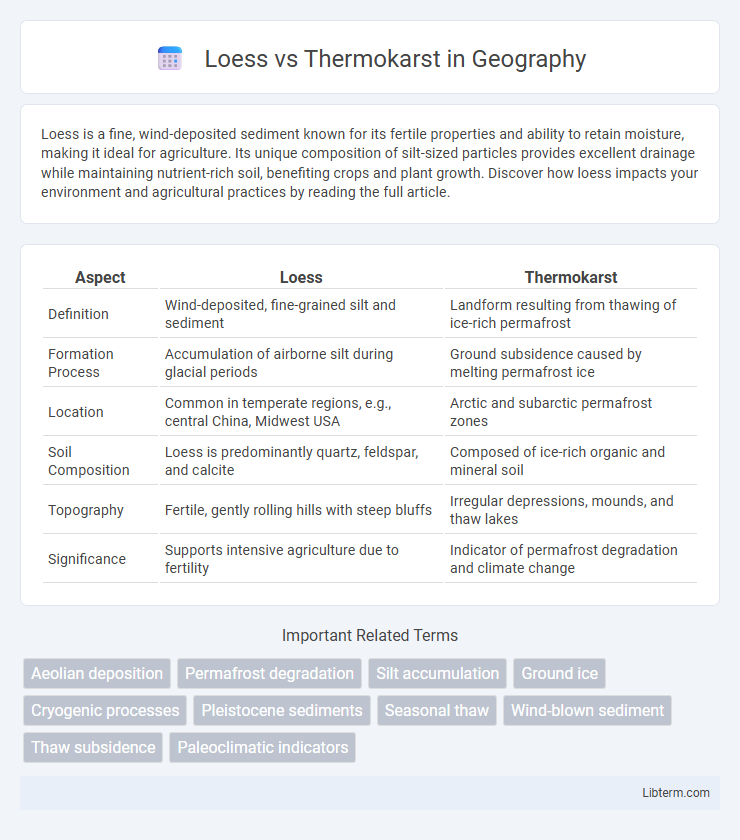Loess is a fine, wind-deposited sediment known for its fertile properties and ability to retain moisture, making it ideal for agriculture. Its unique composition of silt-sized particles provides excellent drainage while maintaining nutrient-rich soil, benefiting crops and plant growth. Discover how loess impacts your environment and agricultural practices by reading the full article.
Table of Comparison
| Aspect | Loess | Thermokarst |
|---|---|---|
| Definition | Wind-deposited, fine-grained silt and sediment | Landform resulting from thawing of ice-rich permafrost |
| Formation Process | Accumulation of airborne silt during glacial periods | Ground subsidence caused by melting permafrost ice |
| Location | Common in temperate regions, e.g., central China, Midwest USA | Arctic and subarctic permafrost zones |
| Soil Composition | Loess is predominantly quartz, feldspar, and calcite | Composed of ice-rich organic and mineral soil |
| Topography | Fertile, gently rolling hills with steep bluffs | Irregular depressions, mounds, and thaw lakes |
| Significance | Supports intensive agriculture due to fertility | Indicator of permafrost degradation and climate change |
Introduction to Loess and Thermokarst
Loess is a wind-blown silt sediment composed primarily of quartz, feldspar, and carbonate minerals, forming extensive deposits that contribute to fertile soils in regions such as the Midwest United States and the Chinese Loess Plateau. Thermokarst refers to land-surface depressions and irregular terrain formed by the thawing of ice-rich permafrost, leading to ground subsidence in Arctic and sub-Arctic environments. Both loess and thermokarst significantly influence landscape morphology, soil properties, and ecological dynamics, but originate from distinct geological and climatic processes.
Definition and Formation of Loess
Loess is a fine-grained, wind-deposited sediment composed mainly of silt-sized particles derived from glacial and desert sources, often forming thick, homogeneous blankets over landscapes. Thermokarst refers to a land surface characterized by irregular depressions and mounds formed by the melting of ice-rich permafrost and subsequent ground subsidence. Loess forms through aeolian processes where strong winds transport and deposit mineral particles during glacial periods, creating fertile soils critical for agriculture.
Definition and Formation of Thermokarst
Thermokarst is a land surface characterized by irregular terrain formed due to the thawing of ice-rich permafrost, resulting in ground subsidence, sinkholes, and depressions. Unlike loess, which consists of wind-deposited silt-sized particles accumulated over time, thermokarst formation is driven primarily by the melting of ground ice in permafrost regions, leading to ground collapse. The process of thermokarst results in distinct geomorphological features such as thermokarst lakes, pits, and hummocks, commonly found in Arctic and sub-Arctic landscapes.
Key Differences Between Loess and Thermokarst
Loess consists of fine, wind-blown silt deposits primarily formed by aeolian processes, whereas thermokarst refers to irregular land surfaces created by the thawing of ice-rich permafrost. Loess deposits are widespread in temperate regions and have a homogenous, unconsolidated texture, while thermokarst landscapes exhibit features like potholes, sinks, and subsidence due to ice melt. The key differences lie in their origin--loess from sediment transport and deposition, thermokarst from permafrost degradation--and their resulting geomorphological characteristics.
Geographic Distribution and Environments
Loess deposits are predominantly found in mid-latitude regions such as the central United States, parts of Europe, and China, where wind-blown silt accumulates in semi-arid environments with sparse vegetation. Thermokarst landscapes occur mainly in Arctic and sub-Arctic permafrost regions, including Siberia, Alaska, and northern Canada, formed by ground ice thawing that causes surface subsidence and irregular terrain. The contrast in geographic distribution highlights that loess landscapes develop in temperate to semi-arid climatic zones, while thermokarst features are characteristic of cold permafrost environments undergoing thermal erosion.
Soil Composition and Physical Properties
Loess is a wind-deposited sediment composed primarily of silt-sized particles with high porosity and good drainage, resulting in fertile, easily erodible soils. Thermokarst forms from ice-rich permafrost thaw, leading to irregular, waterlogged terrain with fine-grained soils rich in organic material and variable stability. Soil composition in loess involves mineral-rich, homogenous particles, while thermokarst soils are heterogeneous, often saturated, and subject to dynamic physical changes due to freeze-thaw cycles.
Ecological and Environmental Impacts
Loess deposits support rich agricultural soils but are highly susceptible to erosion and dust storms, influencing local air quality and vegetation patterns. Thermokarst landscapes, formed by thawing permafrost, cause ground subsidence that disrupts ecosystems, releases greenhouse gases like methane, and alters hydrological systems. The contrasting impacts highlight the vulnerability of loess to degradation and thermokarst to climate-induced transformation, both critically affecting biodiversity and environmental stability.
Human Interaction and Land Use
Loess deposits, formed from wind-blown silt, have been extensively utilized for agriculture due to their fertile properties, supporting dense human settlements and intensive land use over millennia. Thermokarst landscapes, resulting from permafrost thaw, pose challenges to infrastructure stability and land use planning, often leading to the abandonment or adaptation of traditional human activities in Arctic and sub-Arctic regions. The contrasting human interaction with loess and thermokarst terrains highlights the influence of geological substrates on settlement patterns, agricultural practices, and resilience strategies in the face of environmental change.
Climate Change Effects on Loess and Thermokarst
Climate change accelerates the thawing of permafrost, intensifying thermokarst formation through ground subsidence and increasing greenhouse gas emissions such as methane and carbon dioxide. Loess deposits, highly susceptible to erosion and destabilization due to changing precipitation patterns and vegetation loss, face increased degradation risks under warming conditions. The interaction of rising temperatures and altered hydrological cycles exacerbates landscape transformation in both loess regions and thermokarst terrains, impacting soil stability and carbon release dynamics.
Conclusion: Importance of Understanding Loess vs Thermokarst
Understanding the differences between loess deposits and thermokarst landscapes is crucial for accurate geological and environmental assessments. Loess, composed of wind-blown silt, contrasts with thermokarst formations that result from permafrost thaw and ground ice melt. Recognizing these distinctions informs land-use planning, climate change models, and hazard mitigation in cold regions.
Loess Infographic

 libterm.com
libterm.com